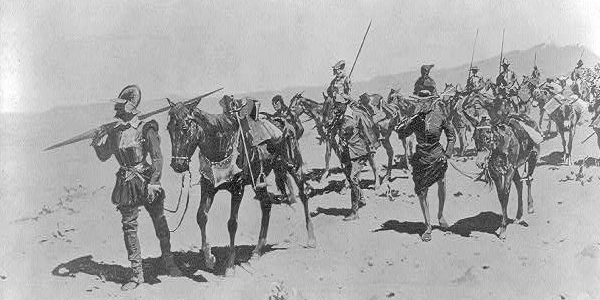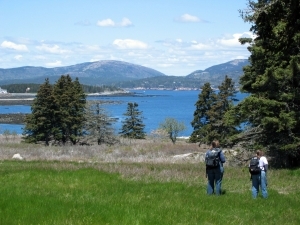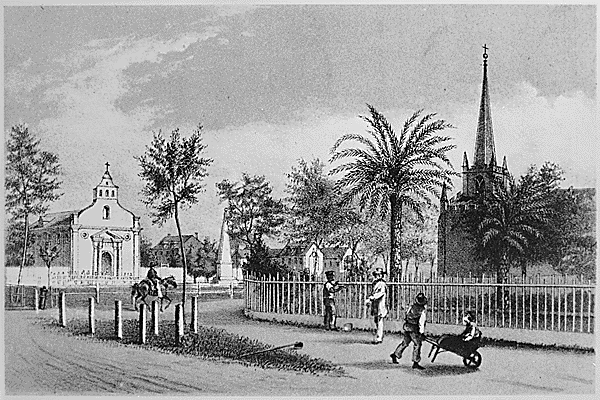Sponsor this page. Your banner or text ad can fill the space above.
Click here to Sponsor the page and how to reserve your ad.
-
Timeline
Detail - 1541
May 8, 1541 - After a Chickasaw raid earlier in the year, de Soto's expedition was in dire shape, however, they push forward, reaching the Mississippi River and becoming the first documented Europeans to witness it. Hernando de Soto led his expeditionary force across the Mississippi River and would explore Texas, Arkansas, and Oklahoma. This expedition lay claims to these territories for the Spanish. De Soto would die early in 1542.

The year had not gone well since the establishment of their camp south of Pontotoc, Mississippi at the end of their expedition in 1540. As spring approached, they would be confronted with a disaster that overwhelmed any that they had encountered during the previous two years, including the Battle at Mabila. A surprise attack by the Chickasaw on March 4, 1540 at their winter camp, precipitated by de Soto's demand from the tribe of two hundred porters, had cost them a dozen men, fifty to sixty horses, three hundred hogs, and most of their clothing and provisions. It might have even been worse, except that the Chickasaw thought the stampeding horses were actually cavalry approaching and a night rain prevented what was intended to be a second attack. A second attack did occur on March 15, but de Soto and his remaining expedition soldiers repelled that effort.
On April 26, 1541, they reached the village of Alimamu. During the ensuing days, raiding parties were sent out by de Soto to attack Indian granaries. They also attacked Fort Alibamo, which was garrisoned by three hundred warriors. The Spanish subdued the fort. The expedition continued through the swamps of Mississippi until May 8, reaching the province of Quizquiz. Some time after reaching this province between May 8 and May 21, they were in sight of what they called the Rio Grande, but actually was the Mississippi River. It is not known, for certain, where the location of the landing, and subsequent crossing, are located. Historians contend it could have been at Sunflower Landing in northern Mississippi or another nearby location extending north in to Tennessee, perhaps near today's Memphis. No matter its location, Hernando de Soto was not impressed. The Mississippi River only presented an obstacle for his expedition. The river was crossed on June 18, 1841.
Primary Source Quotes
"Saturday, May 21, ... the force went along a plain between the river and a small village, and set up quarters and began to build four barges to cross over to the other side. Many of these conquerors said this river was larger than the Danube," Rodrigo Ranjel, May 21, 1541.
"It (the crossing) was nearly a half league wide, and if a man stood still on the other side, one could not tell whether he were a man or something else. It was of great depth and of very strong current. Its water was always turgid and continually many trees and wood came down it borne along by the force of the water and current. It had abundance of fish of various kinds, and most of them different from those of the fresh waters of Spain as will be told hereafter," Juan Ortiz Elvas, May 1541.
"Next day, Wednesday, March 29, the governor reached Nilco. He lodged with all his men in the cacique's town which was located on a level field, and which was all populated for a quarter of a league; while a league and a half-league distant were other very large towns where there was a quantity of maize, beans, walnuts, and dried plums. This was the most populous region which had been seen in Florida and more abounding in maize, with the exception of Coca and Apalache," Juan Ortiz Elvas, March 29, 1542.

The Expedition Through 1542
With the Mississippi River now crossed, the expedition continued to explore the villages of today's state of Arkansas. The first, Aquixo, on June 19, followed by the land of Casqui on June 23. The expedition split, at various times, into parties searching for gold, but none was found, or for food, although the tribes in the area spent little time on agriculture. Large cows, bison, roamed the area. They spent until July 29 in the area of Pacaha. They reached a village by the river called Aquiguate on August 5, rich in fertile land with extensive cultivated fields. They headed into the mountains after that, again searching for gold, reaching the town of Coligua on September 1, 1541.
At the beginning of October, De Soto explored the province of Tula, engaging with the Indians on October 8 in what members of the party deemed the best fighters amongst the tribes. By November 2, 1541, they had reached Utiangue, a village situated on a plain near the River of Cayas, where they built a stockade and wintered.
On March 6, 1542, the expedition left their winter camp and continued their explorations, now reduced in number to three hundred plus men and forty horses, arriving at Guachoya on the western bank of the Mississippi River. Hernando de Soto came down with a fever and died on May 21, 1542. Luis de Moscoso had been chosen as his successor as head of the expedition.
Moscoso and the other leaders eventually agreed that the expedition should end. Half of the men had been lost; they were wearing animal skins as clothing. At first, they attempted to reach Mexico over land through Texas, but that land was too dry and without enough food for the still large force. They headed back to the Mississippi River, built seven pinnaces, then waited for the next spring. On July 2, 1543, the remainder of the expedition sailed down the Mississippi River toward the Gulf Coast, battling fifty to one hundred canoes of the Quigualtam and other tribes who attempted to halt their passage. Eleven additional Spaniards were killed over the next two weeks.
Once they reached the Gulf of Mexico on July 18, they sailed along shore until reaching the Pánuco River in Mexico on September 10, 1543. One month later, they reached Mexico City; three hundred and eleven of the expedition had survived from the original six hundred and twenty.
Image above: Painting of Discovery of the Mississippi by De Soto in the Capitol Rotunda, 1853, William Henry Powell. Courtesy Architect of the Capitol via Wikipedia Commons. Image below: Montage (left) Drawing, "The Caravals Had Arrived," 1898, George Gibbs; (right) Hernando de Soto, date unknown, J. Maca. Both courtesy Library of Congress. Source info: Wikipedia; Final Report of the United States De Soto Expedition Commission in 1939, De Soto National Trail Study, 1988, National Park Service; "True Relation of the Hardships Suffered by Governor Fernando de Soto and certain Portuguese Gentleman During the Discovery of the Province of Florida, Gentleman of Elvas," Juan Ortiz Elvas, 1557/1609, floridahistory.com; "The Inca," 1605, Garcilaso de la Vega; Diary of Rodrigo Ranjel, de Soto secretary, La Historia general y natural de las Indias, Gonzalo Fernándex de Oviedo y Valdés, 1851/1904; Report by Luys Hernández de Biedma, 1544/1851.





